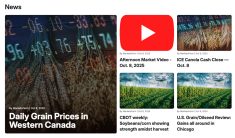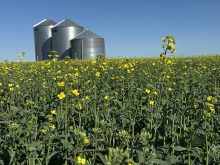Fed cattle see late rally
Fed cattle prices were steady to 50 cents per hundredweight higher last week, said Canfax.
The week started slow with bids lower than the week before, but most feeders were willing to wait or export to the U.S.
Packer interest picked up midweek. For the week, volume sold through Canfax members rose nine percent to about 36,000 head.
Some packers now have two weeks of inventory.
Alberta prices Aug. 25 were steers $137.30-$139.90 per cwt., heifers $84.50 and flat rail $138-$141.
Read Also

Huge Black Sea flax crop to provide stiff competition
Russia and Kazakhstan harvested huge flax crops and will be providing stiff competition in China and the EU.
The surprising strength of the U.S. market late last week should help keep pressure on Canadian packers to hold the basis close to where it’s been, Canfax said.
But with the stronger Canadian dollar and packers’ fairly good inventory, the relationship between Canadian and United States prices might not be as strong as hoped.
Feedlots will need to continue to price enough cattle into the U.S. to keep bids as honest as possible, said Canfax.
The supply of trucks able or willing to do U.S. business has been a limiting factor.
Exchange pinches beef
Canadian cutouts two weeks ago gained $1-$2 per cwt. with AAA at $165 and AA at $156. Compared to a year ago, prices are $8-$13 per cwt. lower, said Canfax.
Cutouts last week were likely lower due to the stronger Canadian dollar.
U.S. cutouts lost $1.38 US on Choice product and $2.50 on Select. Trade was brisk at the lower prices.
Calgary wholesale prices for delivery this week are steady at $142-$144 Cdn.
Feeders mixed in heavier trade
More yearlings moved from grass into the auction markets.
Alberta auction markets volume rose 12 percent to about 41,000 head, more than double the same week last year, Canfax said.
Early week trade was sluggish but picked up later.
Steers 500-800 lb. were $1-$2.50 higher, while 800-900 lb. and heavier steers traded $1 lower.
Heifers 500-600 lb. fell $2.50, 600-800 lb. rose 75 cents-$1.50, and 800-900 lb. and heavier were steady to $1 lower.
D1, 2 slaughter cows and butcher bulls felt the pressure of more volume.
D1, 2 cows traded $1.50 softer, while butcher bulls fell $4.75.
Feedlots are assessing whether to jump into the market at today’s prices and projected break-evens, said Canfax.
Volumes are expected to continue increasing, although wet conditions in some areas may delay cattle coming off grass until pastures dry out.
Stock bred cow and heifer trade in northern Alberta was $500-$850. Cow-calf pairs in central and northern Alberta brought $700-$1,310.
Hog prices rise
With stronger than expected pork prices, packers were able to maintain profitable operating margins and pay more for hogs. Hog futures also rose.
Normally at this time of year, hog supply increases and demand wanes as summer moves to a close. But demand has held up and hog growth is still set back because of the heat earlier this summer in the U.S.
The U.S. Department of Agriculture estimated week-to-date slaughter through Aug. 27 at 1.978 million head, down 0.7 percent from the week before.
For the year, U.S. hog slaughter is down 0.5 percent from the year before.
The Iowa-southern Minnesota cash price Aug. 26 was $52 US, up from $50 the week before.
The pork cutout hit a three-month high. The USDA composite pork carcass cutout value Aug. 26 was $75.49 US, up from $74.48 Aug. 19.
The Chicago lean hogs futures contracts rose with some months setting contract highs.
Sheep, lambs higher
Ontario Stockyards Inc. reported 1,841 sheep and lambs and 220 goats sold. All classes of lambs sold $5 to $8 higher. Sheep sold $5 higher. Goats sold steady.
















